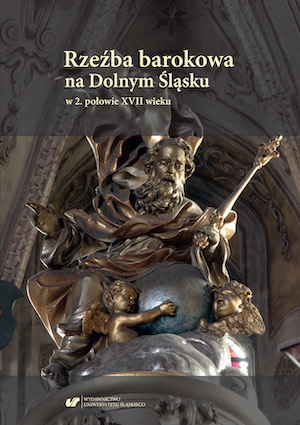Georg Zeller (około 1638–1716) i środowisko artystyczne w którym tworzył w świetle ksiąg metrykalnych
Georg Zeller (ca 1638–1716) and the artistic milieu in which he worked in the light of parish registers
Author(s): Artur Kolbiarz
Subject(s): Fine Arts / Performing Arts, Visual Arts, History of Art
Published by: Wydawnictwo Uniwersytetu Śląskiego
Summary/Abstract: Georg Zeller is an artist known to scholars studying early modern sculpture in Silesia, but information about him does not go beyond the early period in his work. What can help to fill the existing gaps and introduce some order into the current information chaos are records from the Wrocław birth, marriage and death registers. Among the names of the sculptor given in the literature – Georg, Franz, Joseph – only the first one is correct. Zeller was born in 1638 in the Bavarian city of Ansbach. He settled in Wrocław shortly after finishing his professional education, around 1662, and initially worked for the Norbertine Monastery. As a consequence of this collaboration, he belonged to the Parish of St. Vincent. There, in 1667, he married Dorotha Knockner and baptised his sons: Sixtus (1668) and Johann Caspar (1670). Around mid-1673 he moved to the neighbouring Parish of St. Matthias, run by the Knights of the Cross with the Red Star, and settled near the auxiliary Church of St. Agnes. The year 1673 was marked by the baptism of his daughter Anna Rosina, who in 1701 married the sculptor Johann Frörix, and 1707 – by the death of Dorotha. In 1709 the widower married Maria Scholtze from Kąty Wrocławskie. Two years later the couple had a son, Franz Anton. The old artist died in 1716.
Both monasteries, together with the Jesuits and the Poor Clares, made up the biggest Catholic enclave in predominantly Lutheran Wrocław. Around 1700 similar enclaves functioned in the southern (Parishes of St. Dorotha and Corpus Christi), eastern (Dominican Monastery) and south-western part of the city (Reformanti Franciscan Monastery). These locations were attractive to artists because of the ongoing Baroquisation and construction of churches, as is evidenced by the presence of numerous sculptors making up the core of Wrocław’s artistic milieu of Catholic denomination.
Throughout his life in Wrocław Zeller may have functioned as a non-guild artisan, taking advantage of a monastery artist’s immunity. He often collaborated with numerous artists employed by the monks: carpenters, painters and sculptors, working on both monastic commissions and those outside monastic patronage, which he took on increasingly as time went by. He was one of those artists who carefully watched their competitors, modifying the formal language of his works. Combining his own, traditional education with solutions he observed in the work of younger artists, he adopted forms characteristic of mature Baroque art, as a result of which he was able to stay on the market for as long as five decades.
Book: Rzeźba barokowa na Dolnym Śląsku w 2. połowie XVII wieku
- Page Range: 41-57
- Page Count: 18
- Publication Year: 2020
- Language: Polish
- Content File-PDF

